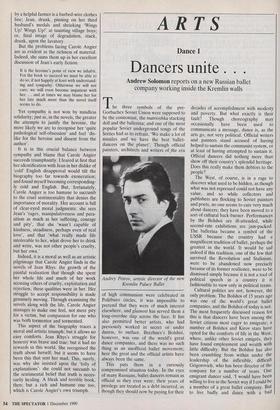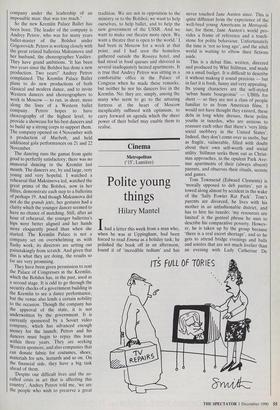ARTS
Dance 1
Dancers unite . .
The three symbols of the pre- Gorbachev Soviet Union were supposed to be the cosmonaut, the matrioshka stacking doll and the ballerina; and one of the most popular Soviet underground songs of the Sixties had as its refrain, 'We make a lot of missiles and we have the best ballet- dancers on the planet'. Though official painters, architects and writers of .the era Andrey Petrov, artistic director of the new Kremlin Palace Ballet of high communism were celebrated in Politburo circles, it was impossible to pretend that they were of much interest elsewhere, and glasnost has served them a long-overdue slap across the face. It has also permitted better artists, who had previously worked in secret or under duress, to surface. Brezhnev's Bolshoi, however, was one of the world's great dance companies, and there was no such thing as an unofficial ballet movement; here the great and the official artists have always been the same.
This puts them in a curiously compromised situation today. In the eyes of many Russians, ballet dancers remain as official as they ever were; their years of privilege are treated as a debt incurred, as though they should now be paying for their decades of accomplishment with modesty and poverty. But what exactly is their fault? Though choreography may occasionally have been used to communicate a message, dance is, as the arts go, not very political. Official writers and painters stand accused of having helped to sustain the communist system, or at least of having attempted to sustain it. Official dancers did nothing more than show off their country's splendid heritage. Does this really make them debtors to the people?
The West, of course, is in a rage to discover what used to be hidden, as though what was not repressed could not have any value, and so while collectors and publishers are flocking to Soviet painters and poets, no one seems to care very much about dancers; they have been moved to a sort of cultural back-burner. Performances by the Bolshoi are ill-attended, while second-rate exhibitions are jam-packed. The ballerina became a symbol of the USSR because the country had a magnificent tradition of ballet, perhaps the greatest in the world. It would be sad indeed if this tradition, one of the few that survived the Revolution and Stalinism, were to be abandoned now precisely because of its former resilience, were to be dismissed simply because it is not a tool of political speech in a country it is fashionable to view only in political terms.
Cultural politics are not, however, the only problem. The Bolshoi of 15 years ago was one of the world's great ballet companies, and the Bolshoi of today is not. The most frequently discussed reason for this is that dancers have been among the Soviet citizens most eager to emigrate; a number of Bolshoi and Kirov stars have opted for the comforts of life in the West, where, unlike other Soviet emigres, they have found employment and wealth with little difficulty. But the Bolshoi has also been crumbling from within under the leadership of the inflexible, difficult Grigorovich, who has been director of the company for a number of years. One emigrant dancer said, 'I would have been willing to live in the Soviet way if I could be a member of a great ballet company. But to live badly and dance with a bad
company under the leadership of an impossible man: that was too much.'
So the new Kremlin Palace Ballet has been born. The leader of the company is Andrey Petrov, who was for many years ballet-master of the Bolshoi under Grigorovich. Petrov is working closely with the great retired ballerina Maksimova and her husband, the choreographer Vasiliev. They have grand ambitions. 'It has been two years since the Bolshoi has done a new production. Two years!' Andrey Petrov complained. The Kremlin Palace Ballet plans to do new productions of both classical and modern dance, and to invite Western dancers and choreographers to work in Moscow — to run, in short, more along the lines of a Western ballet company. Petrov hopes to have choreography of the highest level, to provide a showcase for his best dancers and to build up a strong corps to support them. The company opened on 4 November with a production of Macbeth, and held additional gala performances on 21 and 22 November.
The dancing runs the gamut from quite good to perfectly satisfactory; there was no Immortal dancing in the Kremlin last month. The dancers are, by and large, very young and very hopeful. I watched a rehearsal that Maksimova led, watched the great prima of the Bolshoi, now in her fifites, demonstrate each step to a ballerina of perhaps 19. And though Maksimova did not do the grands fetes, her gestures had a clarity which the younger dancer seemed to have no chance of matching. Still, after an hour of rehearsal, the younger ballerina's hips were better aligned and her hands more eloquently posed than when she started. The Kremlin Palace is not a company set on overwhelming us with flashy work; its directors are setting out painstakingly from scratch. And given that this is what they are doing, the results so far are very promising.
They have been given permission to rent the Palace of Congresses in the Kremlin, which the Bolshoi has, in the past, used as a second stage. It is odd to go through the security checks of a government building in the Kremlin to see a dance performance, but the venue also lends a certain nobility to the occasion. Though the company has the approval of the state, it is not underwritten by the government. It is currently sponsored by a Soviet video company, which has advanced enough money for the launch; Petrov and his dancers must begin to repay this loan within three years. They are seeking Western sponsors, and also companies that can donate fabric for costumes, shoes, materials for sets, leotards and so on. On the financial side, they have a big task ahead of them.
'Despite our difficult lives and the so- called crisis in art that is affecting this country', Andrey Petrov told me, 'we are the people who wish to preserve a great tradition. We are not in opposition to the ministry or to the Bolshoi; we want to help ourselves, to help ballet, and to help the new government of the USSR. And we want to make our theatre more open. We want a theatre that is open to the world.' I had been in Moscow for a week at that point, and I had seen the homeless gathered outside the Rossiya hotel, and had stood in food queues and shivered in several inadequately heated apartments. It is true that Andrey Petrov was sitting in a comfortable office in the Palace of Congress when he made these remarks, but neither he nor his dancers live in the Kremlin. No: they are, simply, among the many who seem to go to the amazing fortress at the heart of Moscow inexplicably suffused with optimism, to carry forward an agenda which the sheer power of their belief may enable them to realise.











































































 Previous page
Previous page